Watermarks on the Dowager and Surcharged Issues
Part 1: The First and second Printings
Tony T.W. Kwan
The study of the Dowager issues and their surcharges is interesting from many points of view — there are, among other things, differences in printings, shades, perforation, cancellations, watermarks and surcharge settings. The issue was suggested by Sir Robert Hart, Commissioner of Customs, to arouse the Dowager Empress's interest in postal matters, and to commemorate her 60th birthday on 7 November 1894. The set of nine values, from 1 Candarin to 24 Candarins, was designed by R.A. de Villard, a French member of the Customs staff.
There were four printings, all produced in Shanghai, including the redrawn fourth printing. This is supported by the existence of the retouched '3' and ![]() (Figure 1) on both the first and second printings. According to memoranda submitted to the Inspector General of I.M. Customs by de Villard on 22 August 1896, a total of 1,927,320 stamps were originally printed, in the following denominations:
(Figure 1) on both the first and second printings. According to memoranda submitted to the Inspector General of I.M. Customs by de Villard on 22 August 1896, a total of 1,927,320 stamps were originally printed, in the following denominations:
|
1 Candarin 2 Candarins 3 Candarins 4 Candarins 5 Candarins 6 Candarins 9 Candarins 12 Candarins 24 Candarins Total | 838 sheets of 240 1,090 sheets of 240 1,696 sheets of 240 1,046 sheets of 240 1,044 sheets of 240 1,464 sheets of 240 691 sheets of 150 337 sheets of 150 336 sheets of 150 8,542 sheets | 201,120 261,600 407,040 251,040 250,560 351,360 103,650 50,550 50,400 1,927,320 |
The paper and its watermark — the Tai Chi (Yin Yang) symbol — were the same as those used for the small dragon issues of 1885 –1888. The paper was made in England. The stamps were gummed and perforated (11½ x 12).
In 1896 Sir Robert Hart again took up the proposal that China should join the Universal Postal Union: his first step was to alter the currency from the old system of Taels and Candarins to the metric Dollars and Cents. On 2 January 1897 the unissued portion of the first printing was issued with overprints and surcharges in Cent values, with small Arabic figures.
Because of the demand for new currency stamps, and the delay in delivery of the 'Imperial Chinese Posts' issues from Japan, the second printing was made early in 1897. The whole of the print run was surcharged with large Arabic figures, 2.5 mm below the Chinese denomination and issued in March 1897. The earliest postmark recorded is 8 March 1897, cancelled with the Customs Shanghai Circular date stamp (Figure 2). While the surcharging of the second prints was in progress, a small number of unsurcharged first printing were returned from post offices throughout China. These stamps were surcharged together with the second printing. As a result, some denominations of the first printing surcharged with large figures (2.5 mm spacing) were produced. These are extremely rare with for example, mint copies of ½ Cent on 3 Candarins, 8 Cents on 6 Candarins and 10 Cents on 12 Candarins.
 Figure 1. Second printing 9 Candarin with retouched Chinese |  Figure 2. Shanghai customs, 8 March 1897. Circular Date stamps. Earliest cancellation on large figures 2.5mm surcharged issues. |
The third printings were arranged and surcharged with large Arabic figures 1.5 mm below the Chinese characters, to cope with the lack of supplies of the large-figure wide-spaced surcharges. This issue was released in May 1897. Small quantities of the first printing, returned from remote post offices, were surcharged with the large figures, with a 1.5 mm space between the value and the Chinese characters. Only two mint copies of the 2 Cent on 2 Candarins and 17 mint copies of the 30 Cent on 24 Candarins are known to exist from this first printing surcharge.
Two redrawn stamps were brought into use later in 1897 when supplies of two values of the May 1897 surcharges (½ Cent and 2 Cents) were exhausted.
A number of articles exist outlining methods of distinguishing between the first and second printings by printing characteristics, colour, gum, perforation, centring, the size of the stamps, and so on. A great deal, however, depends on the condition of the stamps, which were, after all, produced almost a hundred years ago. Climatic changes or dampness can affect colours and gums, leading to difficulties in separating the printings. In addition, there is no standard for colours or gums, and most Dowager collectors are confused by catalogue descriptions if they do not have the opportunity for comparative study of the various printings.
The execution of the printing is an important tool in separating the first and second printings, but it is difficult for general collectors to decide whether the stamp in question is from the first or second printing, although a Dowager expert can distinguish various printings by viewing a black and white photograph.
The first printings are generally well-centred and fairly clear, with 11½ x 12 perforations. But this is not always the case, and should only be used in conjunction with other criteria. It is dangerous to use width as a determining factor when trying to decide whether a stamp is a first or second printing, since paper shrinkage can affect such measurements.
Positive identification I am currently making a study of watermarks of the Dowager issue and its surcharges. The Tai Chi watermark was introduced in China in early 1885, on the small dragon issues, to protect the stamps against forgery. Watermarks were produced in the paper manufacturing process, when the Dandy roll with Tai chi symbols rolled over the pulp, resulting in uneven thicknesses of paper. As the watermarked paper was variable in quality, this resulted in the watermark sometimes being difficult to see.
After viewing over 5,000 Dowager issues, either in my collection, from other collectors or in auctions, I have discovered that the Tai Chi on all first printings are clearer and more easily distinguishable than on the second printings. By comparison, the watermarks on all second printings are difficult to see. Figures 3, 4, and 5 show the colour/watermark of the first printings without surcharge but with large figures 2.5 mm and large figures 1.5 mm surcharged, respectively. Comparing these with the large figures 2.5 mm surcharged on the second printing (Figure 6), the watermark on the latter is not so clear.
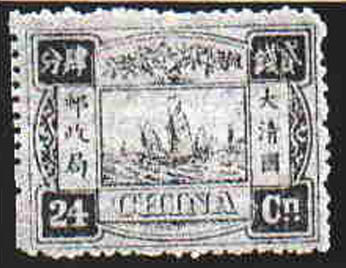 Figure 3a. First printing, unsurcharged – front | 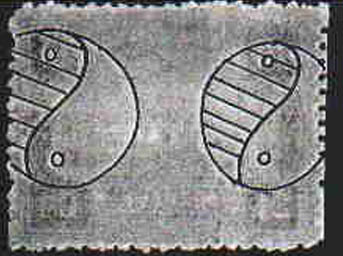 Figure 3b. First printing, unsurcharged – back, with watermarks outlined in black. |
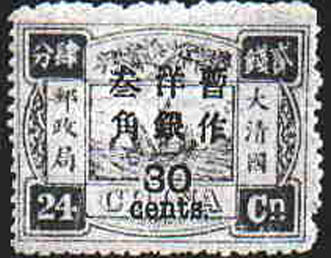 Figure 4a. Large figures, 2.5mm, surcharged on first printing – front | 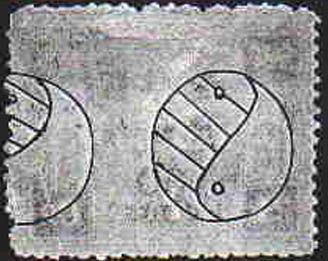 Figure 4b. Large figures, 2.5mm, surcharged on first printing – back, with watermarks outlined in black. |
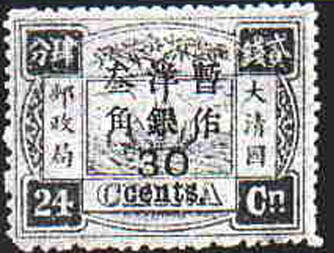 Figure 5a. Large figures, 1.5mm, surcharged on first printing – front | 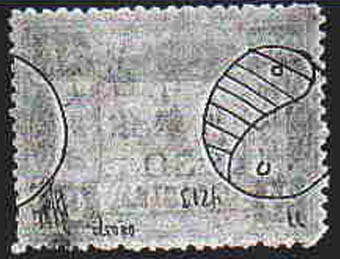 Figure 5b. Large figures, 1.5mm, surcharged on first printing – back, with watermarks outlined in black. |
 Figure 6. Large figures, 2.5mm, surcharged on second printing – front |
The use of watermarks to distinguish between the 1894 and 1897 issues can apply to toned or yellowish paper, stamps whose colour has faded and those without gum: it is a positive identification method. There is only one exception — the watermarks on the 2 Candarin second printings are easy to see because the paper and grains are similar to those of the first issue. Fortunately, all 2 Candarin second printings can be distinguished easily by their yellowish green colour.
I suggest the following steps to inspect a Dowager stamp:
- Inspect the watermark by holding the stamp up to a light source or by using a signoscope. First printings should have a clear and distinct watermark.
- Check the colour and compare the colours as stated in the major catalogues.
- Compare the execution with the 1894 issues, and the 1897 large figures 2.5 mm surcharged issues. If it is close to the 1894 unsurcharged issues, it might be a first printing. Otherwise, it is a second printing.
- For mint stamps, the gums can be used to check printings. The gums on first printings are yellowish, thick and applied evenly. On the other hand, the gums on second printings are whiter, thinner and uneven. However, in some cases the gums will turn yellow due to climatic changes.
- Check the centring of stamps: the first printings are generally well-centred.
If a stamp satisfies conditions 1, 2 and 3 it is most likely a first printing issue. Steps 4 and 5 can be used to supplement steps 1 and 2. I hope this proves an easy method for you of distinguishing between the first and second Dowager printings.